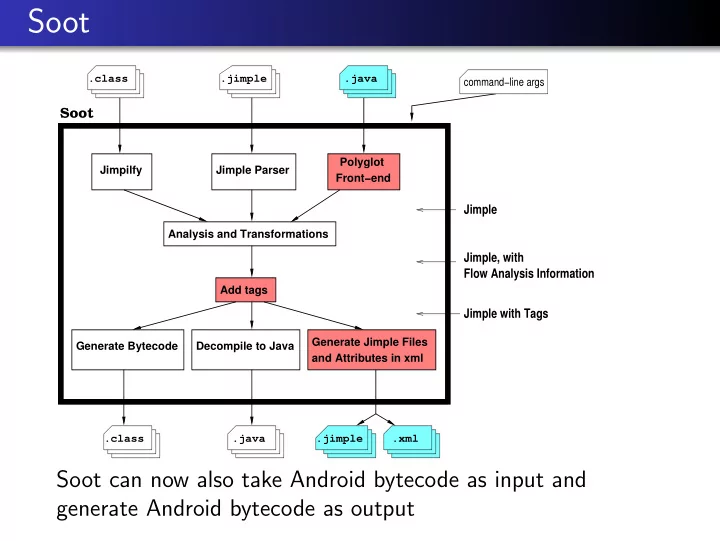

Soot .class .jimple .java command−line args Soot Polyglot Jimpilfy Jimple Parser Front−end Jimple Analysis and Transformations Jimple, with Flow Analysis Information Add tags Jimple with Tags Generate Jimple Files Generate Bytecode Decompile to Java and Attributes in xml .class .java .jimple .xml Soot can now also take Android bytecode as input and generate Android bytecode as output
Soot Resources Soot main page: http://sable.github.io/soot/ Soot download page: http: //www.sable.mcgill.ca/soot/soot_download.html Soot tutorials: https://github.com/Sable/soot/wiki/Tutorials (Temporarily: soot-2.5.0.jar is available through the course website)
Installing Soot Command-line Soot Download soot-2.5.0.jar and add to CLASSPATH environment variable: export CLASSPATH=soot-2.5.0.jar:$CLASSPATH Soot-Eclipse plugin Follow installation instructions at: https://github.com/ Sable/soot/wiki/Running-Soot-as-Eclipse-Plugin
Command-line Examples List command line options java soot.Main --help Process MyClass.class, output .class file java soot.Main MyClass Process MyClass.class, output .jimple file java soot.Main -f jimple MyClass Process MyClass.java, output .class file java soot.Main -src-prec java MyClass Process MyClass.class, output .jimple file with tags java soot.Main -f jimple -print-tags MyClass
Command-line Examples Warning Soot has its own class path and loads only classes from that path. java soot.Main MyClass will not run. Use the -cp option to Soot to specify a path: MyClass will still not run java soot.Main -cp . Need to provide Java library classes: java soot.Main -cp .:<path-to-rt.jar> MyClass will run
Jimple Statements
Jimple Expressions
Soot Classes Scene.v() Scene (singleton) getSootClass() getField() SootClass SootField getSignature() getMethod() SootMethod getSignature() getActiveBody() JimpleBody
Soot Classes SootMethod getActiveBody() getBody() UnitGraph getLocals() JimpleBody Chain new BriefUnitGraph() getTraps() getUnits() Chain Chain getUnits()
“Boxes” (References) s: x = y op z
Soot Attributes We often want to attach annotations to code to convey low-level analysis results, such as register allocation or array bounds check elimination to a VM to convey analysis results to humans to record profiling information
Tags Tags are objects that can be attached to Hosts: package soot.tagkit; public interface Tag { public String getName (); public String toString(); }
Hosts Hosts are objects that can hold Tags: package soot.tagkit; public interface Host { public void addTag (Tag t); public Tag getTag (String aName); public List getTags (); public void removeTag (String name); public boolean hasTag (String aName); } Implementations: SootClass, SootField, SootMethod, Body, Unit, ValueBox
Visual Representations Three visual representations of attribute information: Text displayed in tooltips Color highlighting of chunks of code Pop-up links
String Tags StringTags attach a string of information to a Host. s.addTag(new StringTag(val+": NonNull"));
Color Tags ColorTags attach a color to a Host. v.addTag(new ColorTag(ColorTag.GREEN)); v.addTag(new ColorTag(255, 0, 0));
Link Tags LinkTags attach a string of information, and a link to another part of code to a Host. SootMethod m; String text = "Target:"+m.toString(); Host h = m; String cName = m.getDeclaringClass().getName(); s.addTag(new LinkTag(text, h, cName));
Recommend
More recommend